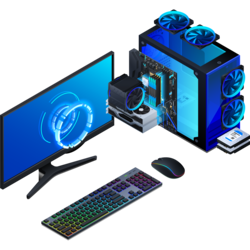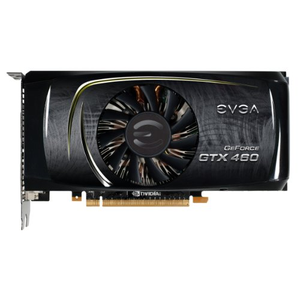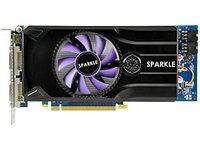General Tasks bottleneck calculator
AMD Phenom FX-5000 and NVIDIA GeForce GTX 460
General Tasks
1366 × 768
1 monitor
1. Select purpose
Currently selected:

General Tasks
2. Select processor
Currently selected:
AMD Phenom FX-5000
3. Select graphic card
Currently selected:
NVIDIA GeForce GTX 460
4. Select resolution
Currently selected:
1366 × 768 resolution
(1 monitor)
Calculation result
Bottleneck percentage
When configuring a high-performance computing setup, it's imperative to ensure that each hardware component is well-matched with its counterparts to provide seamless and optimal system performance. In the case of the AMD Phenom FX-5000 and NVIDIA GeForce GTX 460 in the General Tasks with 1366 × 768 and 1 monitor, it appears that hardware compatibility has been achieved superbly, as evidenced by the calculated bottleneck percentage of 0%.

To elaborate, a bottleneck occurs when one component restricts the maximum efficiency of another, leading to suboptimal performance and reduced system effectiveness. However, in this configuration, that is not a concern. Any bottleneck percentage below 5% is generally deemed insignificant, and our current bottleneck value sits at 0%, which means you can expect superior system performance.
Processor and graphic card utilizations
In a computing setup featuring the AMD Phenom FX-5000 and NVIDIA GeForce GTX 460, under the context of General Tasks with a screen resolution of 1366 × 768 and 1 monitor, the processor is expected to have an utilization rate of 82.9%, while the graphics card is projected to be utilized at 76.8%.
It's crucial to understand that these figures signify theoretical maximums based on typical CPU-to-GPU workload distribution ratios for certain tasks or gaming experiences. Achieving these high levels of utilization in real-world settings can be a challenging endeavor.

Playability
- Playable
- Frames per second
-
A game is considered "playable" if it can consistently run at 60 FPS on high settings. This ensures a smooth and visually appealing gaming experience free from lags or stutters.
Heatmap of bottleneck
The heatmap serves as a graphical representation to further confirm the compatibility between the AMD Phenom FX-5000 and NVIDIA GeForce GTX 460. On this heatmap, the x-axis corresponds to the CPU Score, and the y-axis corresponds to the GPU Score. In a perfectly balanced system such as this, the intersection point of the AMD Phenom FX-5000 and NVIDIA GeForce GTX 460 will fall within the "no bottleneck zone."
The "no bottleneck zone" is an area on the heatmap where the hardware components are not only compatible but are also optimally matched to provide peak system performance. When the intersection of the CPU and GPU scores resides in this zone, it is a strong indicator that the system is balanced and will deliver excellent performance for General Tasks. The presence of both the AMD Phenom FX-5000 and NVIDIA GeForce GTX 460 in this zone confirms that neither component will hinder the performance of the other, leading to a seamless and highly efficient computing experience.

Mapping your AMD Phenom FX-5000 CPU Score against the NVIDIA GeForce GTX 460 GPU Score can provide a comprehensive view of how these components interact and where bottlenecks are most likely to happen. Leveraging this heatmap data could guide you in making more balanced hardware selections suitable for your specific computing needs.
Bottleneck solutions
Replace processor
If your graphic card is causing the bottleneck but you're considering replacing your processor, reconsider this approach. Unless your processor is already on the verge of becoming outdated, upgrading it might not offer a significant performance boost, particularly in graphics-heavy tasks.
- Intel Celeron G3950 Full details
- Intel Core2 Quad Q9550 Full details
- Intel Pentium G4400T Full details
- AMD Phenom II X4 960T Full details
- AMD Phenom II X4 940 Full details
- AMD Athlon II X4 645 Full details
- Intel Celeron G3920 Full details
- AMD A8-3850 Full details
- AMD Phenom II X4 850 Full details
- Intel Core i3-3240 Full details
- Intel Core i3-3220 Full details
- AMD Phenom II X4 830 Full details
- Intel Pentium G3258 Full details
- Intel Core i3-2125 Full details
- AMD Phenom II X4 820 Full details
- Intel Pentium G3260 Full details
- Intel Pentium G2140 Full details
- Intel Core2 Quad Q6700 Full details
- AMD Phenom II X4 B25 Full details
- Intel Core2 Quad Q9400 Full details
- Intel Pentium G3430 Full details
- AMD Phenom II X4 910e Full details
- AMD Athlon II X4 630 Full details
- Intel Core2 Extreme Q6800 Full details
- Intel Core2 Quad Q9505 Full details
- AMD Athlon II X4 631 Full details
- Intel Celeron G5905T Full details
- AMD Phenom II X4 B93 Full details
- Intel Celeron G3900 Full details
- Intel Pentium G3450 Full details
- AMD A6-3670 Full details
- AMD A8-3820 Full details
- Intel Core2 Quad Q9450 Full details
- Intel Celeron J3455E Full details
- Intel Pentium G3440 Full details
- AMD Phenom II X4 973 Full details
- AMD Phenom II X4 920 Full details
- Intel Core2 Quad Q9500 Full details
- Intel Core i3-3210 Full details
- Intel Core i3-3225 Full details
- AMD Athlon II X4 635 Full details
- Intel Xeon X5365 Full details
- Intel Xeon E5-2403 Full details
- Intel Xeon X3363 Full details
- Intel Xeon E5606 Full details
- Intel Xeon X3330 Full details
- Intel Xeon L5420 Full details
- Intel Xeon E5462 Full details
- Intel Xeon X5472 Full details
- Intel Xeon X3353 Full details

Impact of Changing Screen Resolution
Increasing the resolution in this scenario will only make the bottleneck worse, as the GPU will be under even more stress, leading to lower frame rates and reduced graphical quality. It won't significantly ease the load on the already underutilized processor.
Read moreReplace graphic cards
When the graphic card becomes a system bottleneck, upgrading it can provide a significant boost in performance. Opt for a card that better matches the capabilities of your processor to get a more balanced system. This will also enable you to run games and applications at higher settings, offering a vastly improved user experience.
- NVIDIA GeForce GT 1030 Full details
- NVIDIA GeForce GTX 650 Ti Full details
- AMD Radeon RX 550X Full details
- AMD Radeon HD 5970 Full details
- AMD Radeon RX Vega 11 Full details
- NVIDIA GeForce GTX 745 Full details
- AMD Radeon HD 7770 Full details
- AMD Radeon HD 5870 Full details
- AMD Radeon HD 6870 Full details
- NVIDIA GeForce GTX 460 v2 Full details
- NVIDIA GeForce GTX 645 Full details
- NVIDIA GeForce GTX 560 SE Full details
- AMD Radeon R7 450 Full details
- AMD Radeon RX 640 Full details
- AMD Radeon HD 6850 Full details
- AMD Radeon HD 5850 Full details
- NVIDIA GeForce GTX 460 SE Full details
- NVIDIA GeForce GT 645 Full details
- AMD Radeon R9 350 Full details
- AMD Radeon Vega 8 Full details
- AMD Radeon RX Vega 11 Processor Full details
- NVIDIA GeForce GTX 650 Full details
- AMD Radeon R9 M360 Full details
- AMD Radeon Vega 11 Full details
- AMD Radeon RX 540 Full details
- AMD Radeon HD 5830 Full details
- AMD Radeon HD 7750 Full details
- AMD Radeon E8860 Full details
- AMD Radeon RX Vega 10 Full details
- AMD Radeon HD 6790 Full details
- AMD Radeon RX Vega11 Full details
- AMD Radeon Vega 9 Full details
- AMD FirePro 3D V8800 Full details
- AMD Radeon Pro WX 3100 Full details
- NVIDIA Quadro K620 Full details
- NVIDIA Quadro K3100M Full details
- AMD FirePro V7900 Full details
- NVIDIA Quadro 5000M Full details
- AMD FirePro M5100 Full details
- AMD Radeon Pro Full details
- AMD FirePro M6100 Full details
- NVIDIA Quadro 5000 Full details
- NVIDIA Quadro K4000M Full details
- NVIDIA Quadro 5010M Full details
- AMD FirePro 3D V7800 Full details
- AMD FirePro W600 Full details
- NVIDIA Quadro P400 Full details
- NVIDIA Quadro K3000M Full details
- AMD FirePro M4000 Full details
- NVIDIA Quadro K2000D Full details

Impact of Changing Screen Resolution
If your graphics card is bottlenecking the system, lowering the screen resolution will allow the card to handle data more efficiently, resulting in higher frames per second. However, it's worth noting that lower resolutions will require less data processing from the CPU, which could create a new bottleneck there.
Read moreOffers for NVIDIA GeForce GTX 460
 768-P3-1362-TR
768-P3-1362-TR
 01G-P3-1377-TR
01G-P3-1377-TR
 01G-P3-1380-KR
01G-P3-1380-KR
 SXX4602048D5SNM
SXX4602048D5SNM
 SXX460768D5UNM
SXX460768D5UNM
 01G-P3-1378-TR
01G-P3-1378-TR
| Product name | Merchant | Available | Price |
Merchant
Available
Price
|
|---|---|---|---|---|

|
Yes | 94.77 $ |
Yes
|
|
|
MSI Geforce 460GTX 1024 MB DDR5 PCI-Express 2.0 Graphics Card Hawk |

|
Yes | 130.00 $ |
Yes
|

|
Yes | 154.89 $ |
Yes
|
|

|
Yes | 218.00 $ |
Yes
|
Product pricing and availability information was updated as of the date and time listed, but is subject to change. If you choose to purchase a product from a retailer, the price and availability displayed on their website at the time of purchase will apply. We may earn a commission from qualifying purchases made through the links to participating retailers on this site. However, this does not impact the products or prices that are displayed or the order in which prices are listed.
Bottleneck calculator types
Select purpose bottleneck calculator
Before selecting a bottleneck calculator, consider your primary computing tasks. For general activities like web browsing and office work, the calculator evaluates the balance between your CPU and GPU. If you focus on CPU-intensive tasks like video editing or 3D rendering, the tool will highlight processor performance. For GPU-centric tasks such as gaming or graphical rendering, it will assess the efficiency of your graphics card. Choose the appropriate calculator to accurately identify potential system bottlenecks for your specific use-case.
Select game bottleneck calculator
By selecting a game from the list, the calculator will analyze potential bottlenecks specifically tailored to that game's system requirements and graphical demands. This allows you to optimize your setup for a smoother, more responsive gaming experience. Choose the game that aligns with your interests to get the relevant bottleneck analysis.

































